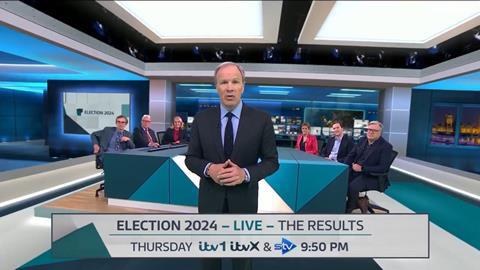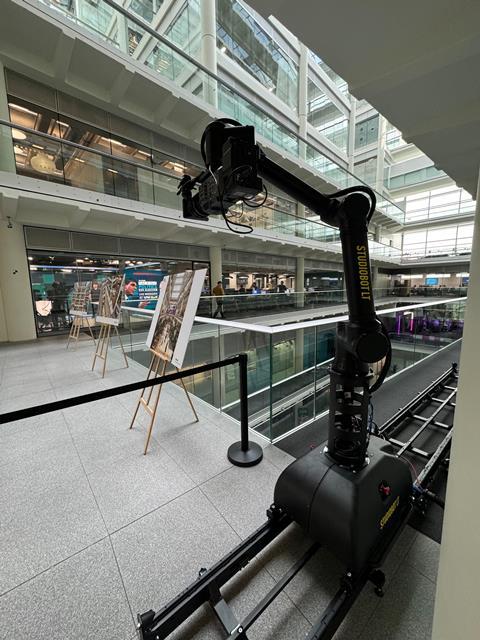The company will be producing content for ITV, Channel 4 and Channel 5 when the public go to the polls

Election night will be an even bigger night for ITN than it is for most. The company will be producing ITV and Channel 4’s live overnight and day after coverage as well as content for Channel 5, with the whole business on hand due to the size of the broadcast.
Head of technical production Jenny King said, “The whole business is very understanding, and some of the other projects do have to pause for a while whilst we’re in this campaign. They’ll pick up again off the back of it because we need to use as much staff as possible to cover this.”
There will be around 100 technical production staff in the ITV studio and around the country, as well as people at every constituency count – many with single camera coverage but not all. There will be two multi-cam OBs, at Sir Keir Starmer’s Camden count the expected first result in Sunderland. Channel 4’s Britain Decides overnight programme will be produced from an external studio in west London.

ITV’s show will be the flagship production for ITN, with two studios, each with its own gallery, in use over eight hours on the night and six the morning after. These will be the ITV news studio, which is fully green screen, and a digital studio which is usually used for ITVX content. The two studios will be linked by a camera on an MRMC StudioBot LT robotic arm on a 4.8 metre track, the first time that such tech has been used in a news programme, to have a shot that links the two rooms through the ITN reception.
The main ITV News studio has been adapted, with a larger desk to accommodate six guests, a, “massive graphic explainer wall,” and a soft area for other interviews. The digital studio already has LED screens for graphics.
Across both, “the foundation really is the graphics and that workflow,” explained King.
Jon Roberts, director of technology, production and innovation, reveals that, “the virtual studio itself will be a living graphic.” He explained, “We never tell the viewers, but you will see in the background that, for example, there are maps of the UK that will paint themselves as the night goes on. Every time a result hits the database, there are bits of the studio that go blue or bits of the studio that go red bits of studio that go other colours.”
Most of the show’s graphics are prepared in advance, and much of the system is automated, “we typically have far fewer graphics operators than is typical in the industry because we rely on quite a lot of automation through elections,” Roberts said.
One area of innovation for these graphics is AI-powered voice control. “[There was] a production communication chain to get that graphic be played out by an operator, two or three elections ago. There were quite a lot of people involved in that chain, and now the director can say result, for example, ‘Godalming,’ and that graphic will appear within about a second or so.”
As the General Election results unfold, join our expert panel, including @NicolaSturgeon, @George_Osborne, and @edballs, as they break down what the results mean for you on ITV1, ITVX and STV from 9:50pm on July 4 pic.twitter.com/E6KrSXsun4
— ITV News (@itvnews) July 2, 2024
AI is also being used in an in-house built transcription tool, and the technology is now maturing, Roberts said. “Voice control has been possible for some time, but AI now allows us to be more ambitious with what we can do with that control, because in theory the system has a richer understanding of what is being said rather than just looking to recognise a word.”
Another common challenge for election night shows is connectivity between the regions and the main studio, and this will be the first general election where ITN will be using IP. King noted, “We’ve got better connectivity to the regions and so you know we can share content much more easily and we’ve got a better ability to share graphics, better ability to share plans.”
Roberts also pointed to the benefits of bonded cellular, “a game changer,” for this, stating that connectivity has begun to become less of an issue over the past decade.
Despite the technical challenges, both King and Roberts say that the organisational challenges are the real test. King said, “I almost see it as a jigsaw. You have all the pieces which need to be built and properly resourced in the planning. If they aren’t correct and don’t slot together on the night, then that’s when we run into problems because it is complex and very interlinked. All of the coverage from the field and the counts and the communication from those people feeding back into the studio, all that has to work. The studio then have to be able to adapt and react to that in order to make sure that the graphics are updated.”
For Roberts, the key moment to see whether everything is going to plan will be early in the night. “The thing I’m most excited to see, honestly, is when the first live declaration happens on the ITV show. There’s a graphic we use as they’re reading out the result, that shows you that result as it happens and then displays and analyses it. The first one of those is always my favourite moment because as much as we can rehearse, we then need to do an awful lot of resetting before the show itself. So the first trigger where we know that the whole results engine is working is when the first result graphic works. When the tally in the bottom corner goes to one, that’s a really lovely moment for me.”








No comments yet